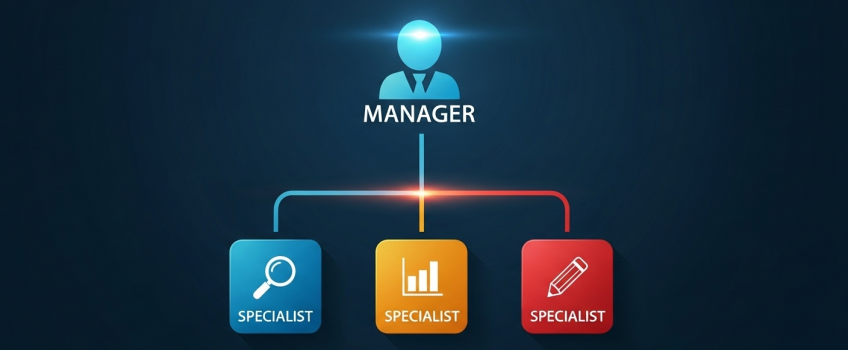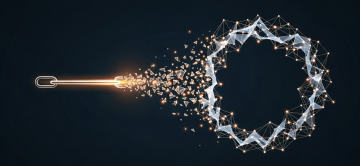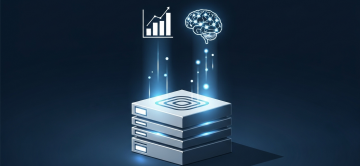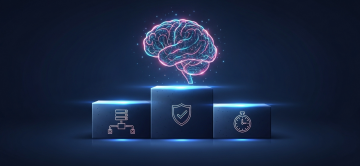Orchestrating Specialist AI Agents with CrewAI: A Guide

The Hierarchical Agent Team: A Practical Guide to Orchestrating Specialist Agents with CrewAI
In the nascent field of AI agents, the default approach is often to build a single, monolithic "do-everything" agent. We give it a complex goal, a dozen different tools, and a lengthy prompt hoping it can figure everything out. This is the AI equivalent of hiring a single junior generalist and asking them to be an expert researcher, a senior writer, and a quality assurance analyst all at once.
The critical "why": This monolithic approach inevitably fails on complex tasks. The agent's context window gets polluted, its focus becomes diluted, and it struggles to switch between different modes of thinking. The solution, inspired by how high-performing human organizations work, is to build a team of specialized agents with a clear reporting structure. At ActiveWizards, we use frameworks like CrewAI to move beyond single agents and architect these robust, hierarchical teams. This guide provides a practical blueprint for this advanced pattern.
The Monolithic Anti-Pattern vs. The Specialist Team
Just like in a company, specialization and delegation lead to better outcomes. An AI agent designed for the sole purpose of searching the web will outperform a generalist agent that has to juggle ten other responsibilities. CrewAI provides the framework to formalize this common-sense structure in code.
| Factor | Monolithic Agent | Hierarchical Agent Team (CrewAI) |
|---|---|---|
| Design | One agent with many tools and a complex prompt. | Multiple agents, each with a specific role and limited tools. |
| Flexibility | Low. Hard to modify or add new capabilities without breaking existing logic. | High. New specialists can be added to the team without disrupting others. |
| Reliability | Brittle. A failure in one sub-task can derail the entire process. | Robust. A manager agent can handle failures from specialists and delegate to others. |
| Performance | Often poor on complex tasks due to context dilution. | Often superior, as each agent is fine-tuned for its specific task. |
The CrewAI Paradigm: Your Digital Org Chart
CrewAI formalizes the concept of an agentic team with a few simple but powerful abstractions:
- Agents: The "workers." Each agent is defined with a specific `role`, `goal`, and a `backstory` to give it context. They can also be assigned specific tools.
- Tasks: The "assignments." A task is a detailed description of a unit of work to be completed by an agent.
- Crew: The "team." This brings together a set of agents and tasks.
- Process: The "management style." This is the most important part. You can define a `Process.sequential` (like a waterfall project) or a `Process.hierarchical`, where one agent acts as a manager, delegating tasks to subordinates.
Diagram 1: An organizational chart for a hierarchical agent team.
Practical Pattern: The Research & Report Crew
Let's build a concrete example: a crew designed to research a topic and generate a detailed report. This team will consist of a manager and two specialists.
1. Define the Agents (The Team Members)
We'll create a `Research Manager`, a `Market Researcher`, and a `Report Writer`. Each gets a specific role and goal.
from crewai import Agent
# Assume 'search_tool' and 'file_write_tool' are pre-defined LangChain tools.
# For example: from langchain_community.tools import DuckDuckGoSearchRun
# search_tool = DuckDuckGoSearchRun()
# The Manager Agent does not have tools, it only delegates.
research_manager = Agent(
role='Senior Research Manager',
goal='Oversee the research and writing process to create an outstanding report.',
backstory='An experienced manager known for delivering high-quality market analysis and ensuring final reports meet the highest standards.',
allow_delegation=True, # This is key for a manager agent
verbose=True
)
# The Specialist Agent for research has a specific tool.
market_researcher = Agent(
role='Market Research Analyst',
goal='Find relevant, up-to-date data and key points about a given topic.',
backstory='A skilled analyst with a knack for finding impactful data online using web search tools.',
tools=[search_tool], # This agent is equipped with a search tool
allow_delegation=False,
verbose=True
)
# The Specialist Agent for writing, with its own role and backstory.
report_writer = Agent(
role='Professional Report Writer',
goal='Synthesize research findings into a clear, concise, and well-structured final report.',
backstory=('An expert technical writer renowned for transforming complex data into'
' compelling narratives. You create reports that are easy to understand,'
' data-driven, and perfectly formatted.'),
# This agent might have a tool to write the final report to a file.
# tools=[file_write_tool],
allow_delegation=False,
verbose=True
)
2. Define the Tasks and the Crew
The manager is given the top-level task. The `process` is set to `hierarchical`, which empowers the manager agent to create new sub-tasks and delegate them to its team members based on their roles.
Diagram 2: The workflow and delegation process within the hierarchical crew.
from crewai import Task, Crew, Process
# The high-level task given to the crew
research_task = Task(
description='Create a comprehensive report on the topic of AI in the finance industry.',
expected_output='A 5-section report with an introduction, key trends, challenges, future outlook, and conclusion.',
agent=research_manager # This task is assigned to the manager
)
# Form the crew with a hierarchical process
project_crew = Crew(
agents=[research_manager, market_researcher, report_writer],
tasks=[research_task],
process=Process.hierarchical, # Manager-led delegation
manager_llm=some_smart_llm # e.g., GPT-4o
)
# Kick off the work
final_result = project_crew.kickoff()
Don't underestimate the `backstory` parameter in the `Agent` definition. It's not just flavor text; it's a critical part of the agent's system prompt. A well-crafted backstory that clearly defines the agent's expertise, constraints, and expected output quality significantly improves its performance and reliability. For a `Report Writer` agent, a backstory like "You are an elite financial journalist known for clear, concise, and data-driven writing. You never use fluff and always cite your sources." is far more effective than "You are a writer."
Production-Level Considerations for Multi-Agent Systems
Moving a CrewAI system from a script to a production service requires careful engineering.
- Tool Security & Sandboxing: How do you ensure an agent's tools can't access sensitive data or perform destructive actions? Tools should operate with the principle of least privilege and be run in a sandboxed environment where possible.
- Cost and Performance Monitoring: A hierarchical crew can make many LLM calls. You must have a system to monitor token usage and overall execution time to prevent runaway costs and identify performance bottlenecks.
- State Management for Long-Running Crews: The default CrewAI process is synchronous and in-memory. For tasks that take minutes or hours, you need to architect an asynchronous system with an external state store (e.g., Redis, a SQL DB) to manage the crew's progress.
- Observability & Debugging: Debugging a team of interacting agents is complex. Integrating with a tool like LangSmith is essential to trace the delegation, tool calls, and LLM conversations within the crew.
The ActiveWizards Advantage: Architecting Your Digital Workforce
Designing a single AI agent is a solved problem. Architecting a reliable, scalable, and observable team of collaborating agents is the next frontier of enterprise AI. This requires more than just prompt engineering; it demands a deep understanding of distributed systems, workflow orchestration, and robust software engineering principles.
At ActiveWizards, we specialize in building these sophisticated multi-agent systems. We go beyond simple prototypes to engineer production-grade "digital workforces" that can automate your most complex business processes with unparalleled reliability and intelligence.
Build Your Autonomous Agent Team
Ready to move beyond single agents and automate complex workflows? Our experts can help you design and build a custom, hierarchical agent team that is scalable, reliable, and ready for the enterprise.



Comments (0)
Add a new comment: